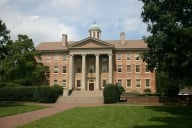You have /5 articles left.
Sign up for a free account or log in.
“Expansions don’t die of old age.” -- Janet Yellen
Those of us who were in the community college world in 2008-09 remember the impact of the last recession. For a couple of years, enrollments boomed; in my second year at Holyoke, enrollment went up 13 percent. Section management consisted of finding rooms for more classes and fitting as many students into each as possible. Parking became a much greater challenge; at HCC, as at many other places, tennis courts that had fallen into disrepair were repurposed as overflow parking. We even arranged with the local mall to use the parking lots there as overflow. Time slots that had historically been relatively barren, like late afternoons, actually filled.
The short-term blast of enrollment growth helped to mask cuts in state funding, at least for a while. As long as student numbers were growing rapidly, a shift in revenue sources from the state to students wasn’t too damaging.
One of the most powerful and frustrating constraints on handling the sudden influx was the shortage of faculty and staff. In the decade leading up to the Great Recession, enrollments had increased a percentage point or two per year, and staffing mostly held flat. That was a gradual erosion, but it wasn’t a catastrophe. When the recession-driven influx showed up, we were mostly able to handle it.
The next recession will be very different. And yes, there will be a next recession.
It will be different because it will not be coming on the heels of a decade of relative stability or low growth. It will be coming on the heels of a decade of cuts.
That makes a difference in several ways.
Most basically, it means that we won’t have as much slack in the system to accommodate a sudden surge. Our offices are running leaner, our academic departments are smaller and everyone is pressing already. We have the physical space to accommodate a surge, but we don’t have the personnel.
And every time we get operating aid ratcheted down, it never really recovers. My own college’s public funding level is lower than it was in 2007, even before correcting for inflation. To put that in perspective, after the longest economic expansion on record, with Democrats controlling the governorship and both houses of the Legislature, we got exactly zero dollars in increased operating aid. If we can’t get help now, when can we?
(The governor’s budget for the coming fiscal year proposes an operating increase for public four-year colleges, but no operating increase for community colleges. Again. But it does include price controls, so we can’t even make up the difference that way. Uh, thanks?)
This isn’t the time for austerity. This is the time to build capacity. Recessions happen quickly, and students need us when they need us. If we wait until then, it will be too late. At the last recession, we were coming off a period of growth, and even that was a strain. At the next one, we’ll be coming off years of shedding employees.
We like to talk about community college enrollments as countercyclical, and that’s true. But that presumes enough steady-state capacity to support a surge. In this expansion, the public sector has simply failed to rebuild what it attacked the last time around.
Recessions abhor a vacuum. If we -- the accredited low-cost providers -- can’t meet the next surge of demand, others will. We’ve already seen how that plays out, and how much it costs to try to undo some of that damage. It’s much cheaper to get it right the first time.
Trees don’t grow to the sky; economic expansions eventually end. The sooner we acknowledge that, the less painful the next recession will be.







